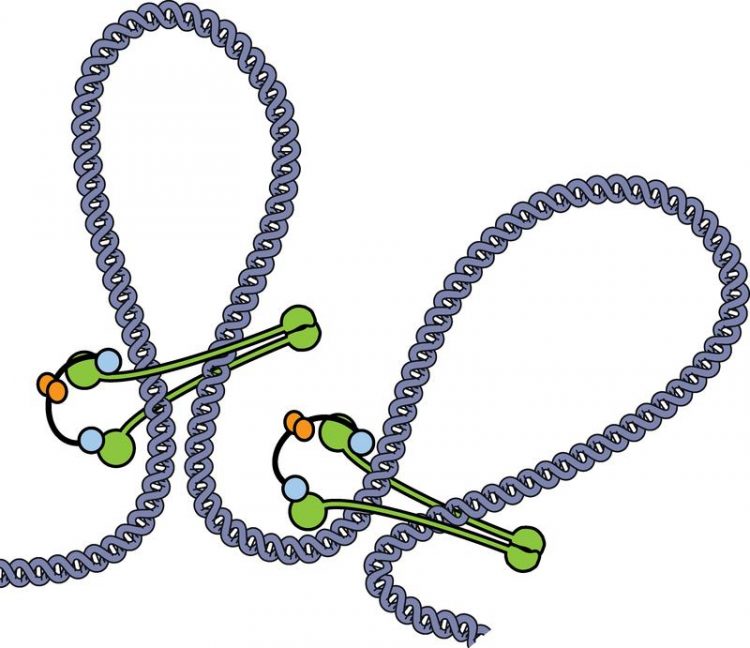What Holds Chromosomes Together – Max Planck Scientists Elucidate Operating Mode of DNA-Packaging

The SMC protein complex (green, blue, orange) embraces the DNA like a clip and thus, keeps the genetic material in order. Larissa Wilhelm / Copyright: MPI of Biochemistry
At the Max Planck Institute (MPI) of Biochemistry in Martinsried near Munich, scientists have now elucidated how this packaging process works in bacteria. Their studies showed that the SMC protein complex holds DNA together like a clip and thus keeps the genetic material in order.
In each human cell, about two meters of DNA must fit into a cell nucleus that has a diameter of only a few thousandths of a millimeter. Here, the DNA is organized in individual chromosomes. In order to ensure the DNA’s secure transport during cell division, the long and coiled DNA fibers must be tightly packed.
So far, scientists have only a sketchy understanding of this step: The SMC protein complexes play a key role in this process. They consist of two arms (SMC) and a bridge (kleisin). Together, they form a ring-like structure. “You can understand how important these protein complexes are when you look at their evolution,” explains Larissa Wilhelm, PhD student at the MPI of Biochemistry. “Structure and operating mode are quite similar in bacteria and humans.”
There are different possibilities as to how the SMC protein complex could pack up DNA. It could for example stick together the different DNA fibers. However, the Max Planck scientists were able to show in bacteria that the SMC protein arms embrace the DNA like a clip, thus enabling the connection of pieces of the DNA that lie wide apart from each other.
In a next step, the members of the research group “Chromosome Organization and Dynamics” want to find out whether the clip either opens for a short period of time in which it embraces already formed DNA loops, or whether the clip first binds to the DNA and then forms DNA loops itself by encasing the DNA.
“Our results could also help to better understand the complex organization of human chromosomes and hereby allow insights into the development of genetic defects such as Trisomy 21” says Stephan Gruber, group leader at the MPI of Biochemistry.
Original Publication
L. Wilhelm, F. Bürmann, A. Minnen, H.-C. Shin, C.P. Toseland, B.-H. Oh, S. Gruber: SMC condensin entraps chromosomal DNA by an ATP hydrolysis dependent loading mechanism in Bacillus subtilis. eLIFE, May 7, 2015.
DOI: 10.7554/eLife.06659
Contact
Dr. Stephan Gruber
Chromosome Organization and Dynamics
Max Planck Institute of Biochemistry
Am Klopferspitz 18
82152 Martinsried
Germany
E-Mail: sgruber@biochem.mpg.de
www.biochem.mpg.de/gruber
Anja Konschak
Public Relations
Max Planck Institute of Biochemistry
Am Klopferspitz 18
82152 Martinsried
Germany
Phone +49 89 8578-2824
E-Mail: konschak@biochem.mpg.de
www.biochem.mpg.de/news
http://www.biochem.mpg.de/en/news – More press release of the Max Planck Institute of Biochemistry
http://www.biochem.mpg.de/gruber – Website of the research group “Chromosome Organization and Dynamics” (Stephan Gruber)
Media Contact
All latest news from the category: Life Sciences and Chemistry
Articles and reports from the Life Sciences and chemistry area deal with applied and basic research into modern biology, chemistry and human medicine.
Valuable information can be found on a range of life sciences fields including bacteriology, biochemistry, bionics, bioinformatics, biophysics, biotechnology, genetics, geobotany, human biology, marine biology, microbiology, molecular biology, cellular biology, zoology, bioinorganic chemistry, microchemistry and environmental chemistry.
Newest articles

Superradiant atoms could push the boundaries of how precisely time can be measured
Superradiant atoms can help us measure time more precisely than ever. In a new study, researchers from the University of Copenhagen present a new method for measuring the time interval,…

Ion thermoelectric conversion devices for near room temperature
The electrode sheet of the thermoelectric device consists of ionic hydrogel, which is sandwiched between the electrodes to form, and the Prussian blue on the electrode undergoes a redox reaction…

Zap Energy achieves 37-million-degree temperatures in a compact device
New publication reports record electron temperatures for a small-scale, sheared-flow-stabilized Z-pinch fusion device. In the nine decades since humans first produced fusion reactions, only a few fusion technologies have demonstrated…





















